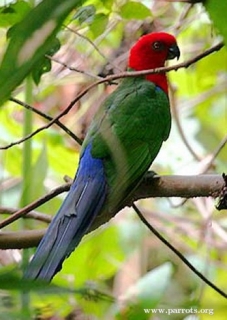Moluccan King Parrot |
|
|
Also known as: Amboina King Parrot, Ambon King Parrot, Island King Parrot, Red Parakeet, Salawati King Parrot (A.a. dorsalis)
Photos
View in GalleryDid You Know?
The Moluccan King Parrot may sometimes be active at night, as it has been seen flying out of the forest across open cultivation at dusk.Academic Research
Related publications: Alisterus amboinensisSpecies Profile
Genus: Alisterus | Species: amboinensis
Size:
35cm (13.6 in)
Weight:
145-163g (5.1-5.7 oz)
Subspecies including nominate:
six: A.a. amboinensis, A.a. sulaensis, A.a. versicolor, A.a. buruensis, A.a. hypophonius, A.a. dorsalis
Colour Adult:
A.a. amboinensis: Both adults red head and underparts; mantle to upper tail coverts violet/blue; wings soft green; tail black washed with violet/blue, the outside feathers with dull pink edging. Upper mandible orange/red tipped with black, lower mandible black. Eye orange.
A.a. sulaensis: As in amboinensis but green stripe across upper mantle; no pink edging on tail feathers.
A.a. versicolor: Different from sulaensis by having a uniformly blue mantle; smaller in size than amboinensis.
A.a. buruensis: As in sulaensis but more tail feathers edged with pink. Bill grey/black in both sexes.
A.a. hypophonius: As in amboinensis but wings and wing coverts deep blue; pink on tail feathers absent.
A.a. dorsalis: As in amboinensis but pink on tail feathers absent; slightly darker red on head and underparts.
Colour Juvenile:
Mantle green; side tail feathers tipped with soft red. Bill brown/black tipped paler. Eye dark brown.
Call:
Calls are high-pitched and slightly ringing, repeated by male at rate of two notes every three seconds for up to 20 seconds. Also screeching from both male and female.
Listen NowVideo Links:
Video 1More Information:
Content Sources:
CITES
BirdLife International
Cornell Lab of Ornithology/Birds of the World
ML Media Collection Catalogue 518111, Moluccan King Parrot (Alisterus amboinensis), DeCicco, Lucas, Maluku, Indonesia, January 8 2016, Cornell Lab of Ornithology. Site
Article "The Kings," Peter Odekerken, Australian Birdkeeper Magazine, April-May 2005.
Parrots: A Guide to Parrots of the World, Juniper and Parr, 1998
Parrots of the World, Forshaw and Cooper, 1977. 2010 edition
Parrots of the World, Forshaw, 2006.
Parrots in Aviculture, Low, 1992.
Psittacine Aviculture, Schubot, Clubb and Clubb, 1992.
Photos
View in GalleryDid You Know?
The Moluccan King Parrot may sometimes be active at night, as it has been seen flying out of the forest across open cultivation at dusk.Academic Research
Related publications: Alisterus amboinensisSpecies Care
Captive Status:
Rare
Longevity:
Probably 30-40 yrs.
Housing:
Walk-in enclosure, minimum length 4.5m (14.7 ft).
Diet:
Small seed mix: canary, oats, safflower; spray millet; limited sunflower seed, dry, soaked or sprouted; sprouted pulses such as mung beans and peas; cooked butterbeans and lentils; boiled maize; green leaves such as: Swiss chard, lettuce, sowthistle, dandelion and chickweed; vegetables such as: corn, carrot, celery, zucchini, green beans and peas in the pod; fruit such as: apple, pear, orange, cactus fruits and bananas; nuts such as: hazelnuts, pecans, roasted peanuts; complete pellet.
Enrichment:
Not recorded.
Nest Box Size:
Vertical box 90-120cm x 25-30cm (35-47 x 10-12 in).
Clutch Size:
3
Incubation Time:
21 days
Fledging Age:
8-9 weeks
Hatch Weight:
7-9g (0.2-0.3 oz)
Peak Weight:
189-225g (6.6-7.9 oz)
Weaning Weight:
168-213g (5.9-7.5 oz)
Photos
View in GalleryDid You Know?
The Moluccan King Parrot may sometimes be active at night, as it has been seen flying out of the forest across open cultivation at dusk.Academic Research
Related publications: Alisterus amboinensisSpecies Wild Status
World Population:
Unknown, decreasing.
IUCN Red List Status:
Least Concern
CITES Listing:
Appendix II
Threat Summary:
Suspected to be in decline owing to habitat destruction. Rare and threatened on Halmahera; confined to primary forest areas on Taliabu (Sula Island), where about 5000 birds survive.
Range:
A.a. amboinensis: S Moluccas, except Buru.
A.a. sulaensis: Sula Islands.
A.a. versicolor: Peleng Island.
A.a. buruensis: Buru, in S Moluccas.
A.a. hypophonius: Halmahera, N Moluccas.
A.s. dorsalis: W Papuan Islands and NW New Guinea.
Habitat:
Occurs from lowlands to around 2100m (6888 ft). Found in dense humid primary and secondary forest, and sometimes in nearby plantations, farmlands and gardens.
Wild Diet:
Feeds on Lithocarpus acorns, as well as the hard fruits, buds and berries of other trees.
Ecology and Behaviour:
Found usually in pairs or small groups; is shy. Remains in thick foliage. When approached will fly to cover calling loudly.
Clutch and Egg Size:
3 broadly elliptical eggs, 33.5 x 26.0 mm (1.3 x 1 in).
Breeding Season:
February-March; nest is in cavity in large tree.
Related Links:
Photos
View in GalleryDid You Know?
The Moluccan King Parrot may sometimes be active at night, as it has been seen flying out of the forest across open cultivation at dusk.Academic Research
Related publications: Alisterus amboinensisMembers Only Resources
Please log-in now to find more research, resources and tools.
Not a Member?
Find more great information:
Gain exclusive access to 600+ pages of additional research, seminars and podcasts, specialists to ask your toughest questions, and dozens of other fun resources - when you become a WPT member.
Join Today >>

































